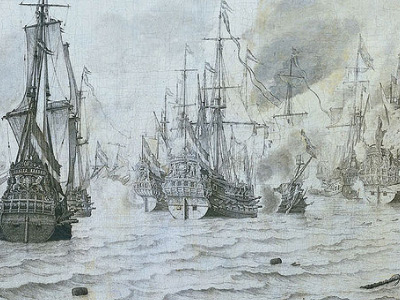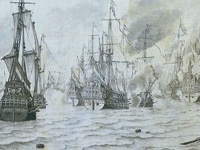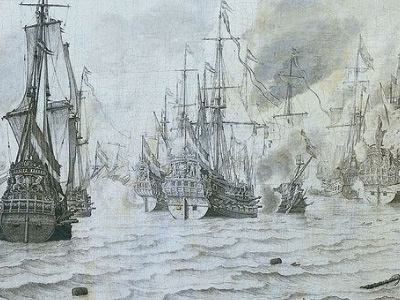Eighty Years' War (1568–1648)

Endgame (1640–1648)
In Asia and the Americas, the war had gone well for the Dutch. Those parts of the war were mainly fought by proxies, especially the Dutch West and East India companies. These companies, under charter from the Republic, possessed quasi-sovereign powers, including the power to make war and conclude treaties on behalf of the Dutch Republic The Dutch Republic was a confederation that existed from 1579, during the Dutch Revolt, to 1795. It was a predecessor state of the Netherlands and the first fully independent Dutch nation state. Although the state was small and contained only around 1.5 million inhabitants, it controlled a worldwide network of seafaring trade routes. The income from this trade allowed the Dutch Republic to compete militarily against much larger countries. It amassed a huge fleet of 2,000 ships, initially larger than the fleets of England and France combined.. After the invasion of Portuguese Brazil by a WIC amphibious force in 1630, the extent of New Holland, as the colony was called, grew gradually, especially under its governor-general Johan Maurits of Nassau-Siegen, in the period 1637–1644. It stretched from the Amazon river to Fort Maurits on the São Francisco River. Soon a large number of sugar plantations flourished in this area, enabling the company to dominate the European sugar trade. The colony was the base for conquests of Portuguese possessions in Africa also (due to the peculiarities of the trade winds that make it convenient to sail to Africa from Brazil in the Southern Hemisphere). Beginning in 1637 with the conquest of Portuguese Elmina Castle, the WIC gained control of the Gulf of Guinea area on the African coast, and with it of the hub of the slave trade to the Americas. In 1641, a WIC expedition sent from Brazil under command of Cornelis Jol conquered Portuguese Angola. The Spanish island of Curaçao (with important salt production) was conquered in 1634, followed by a number of other Caribbean islands.
The Dutch Republic was a confederation that existed from 1579, during the Dutch Revolt, to 1795. It was a predecessor state of the Netherlands and the first fully independent Dutch nation state. Although the state was small and contained only around 1.5 million inhabitants, it controlled a worldwide network of seafaring trade routes. The income from this trade allowed the Dutch Republic to compete militarily against much larger countries. It amassed a huge fleet of 2,000 ships, initially larger than the fleets of England and France combined.. After the invasion of Portuguese Brazil by a WIC amphibious force in 1630, the extent of New Holland, as the colony was called, grew gradually, especially under its governor-general Johan Maurits of Nassau-Siegen, in the period 1637–1644. It stretched from the Amazon river to Fort Maurits on the São Francisco River. Soon a large number of sugar plantations flourished in this area, enabling the company to dominate the European sugar trade. The colony was the base for conquests of Portuguese possessions in Africa also (due to the peculiarities of the trade winds that make it convenient to sail to Africa from Brazil in the Southern Hemisphere). Beginning in 1637 with the conquest of Portuguese Elmina Castle, the WIC gained control of the Gulf of Guinea area on the African coast, and with it of the hub of the slave trade to the Americas. In 1641, a WIC expedition sent from Brazil under command of Cornelis Jol conquered Portuguese Angola. The Spanish island of Curaçao (with important salt production) was conquered in 1634, followed by a number of other Caribbean islands.
The WIC empire in Brazil started to unravel, however, when the Portuguese colonists in its territory started a spontaneous insurrection in 1645. By that time the official war with Portugal was over, as Portugal itself had risen against the Spanish The Spanish Empire was a colonial empire governed by Spain and its predecessor states between 1492 and 1976. One of the largest empires in history, it was the first to usher the European Age of Discovery and achieve a global scale, controlling vast territory. It was one of the most powerful empires of the early modern period, reaching its maximum extent in the 18th century. crown in December 1640. The Republic soon concluded a ten-year truce with Portugal, but this was limited to Europe. The overseas war was not affected by it. By the end of 1645 the WIC had effectively lost control of north-east Brazil. There would be temporary reversals after 1648, when the Republic sent a naval expedition, but by then the Eighty Years' War was over.
The Spanish Empire was a colonial empire governed by Spain and its predecessor states between 1492 and 1976. One of the largest empires in history, it was the first to usher the European Age of Discovery and achieve a global scale, controlling vast territory. It was one of the most powerful empires of the early modern period, reaching its maximum extent in the 18th century. crown in December 1640. The Republic soon concluded a ten-year truce with Portugal, but this was limited to Europe. The overseas war was not affected by it. By the end of 1645 the WIC had effectively lost control of north-east Brazil. There would be temporary reversals after 1648, when the Republic sent a naval expedition, but by then the Eighty Years' War was over.
In the Far East the VOC captured three of the six main Portuguese strongholds in Portuguese Ceylon in the period 1638–41, in alliance with the king of Kandy. In 1641 Portuguese Malacca was conquered. Again, the main conquests of Portuguese territory would follow after the end of the war.
The results of the VOC in the war against the Spanish possessions in the Far East were less impressive. The battles of Playa Honda in the Philippines in 1610, 1617 and 1624 resulted in defeats for the Dutch. An expedition in 1647 under Maarten Gerritsz. de Vries equally ended in a number of defeats in the Battle of Puerto de Cavite and the Battles of La Naval de Manila. However, these expeditions were primarily intended to harass Spanish commerce with China and capture the annual Manila galleon, not (as is often assumed) to invade and conquer the Philippines.
The revolts in Portugal and Catalonia, both in 1640, weakened Spain's position appreciably. Henceforth there would be increasing attempts by Spain to commence peace negotiations. These were initially rebuffed by the stadtholder, who did not wish to endanger the alliance with France The Kingdom of France is the historiographical name or umbrella term given to various political entities of France in the medieval and early modern period. It was one of the most powerful states in Europe since the High Middle Ages. It was also an early colonial power, with possessions around the world. Colonial conflicts with Great Britain led to the loss of much of its North American holdings by 1763. The Kingdom of France adopted a written constitution in 1791, but the Kingdom was abolished a year later and replaced with the First French Republic.. Cornelis Musch, as griffier of the States General, intercepted all correspondence the Brussels government attempted to send to the States on the subject (and was lavishly compensated for these efforts by the French). Frederick Henry also had an internal political motive to deflect the peace feelers, though. The regime, as it had been founded by Maurice after his coup in 1618, depended on the emasculation of Holland as a power center. As long as Holland was divided the stadtholder reigned supreme. Frederick Henry also depended for his supremacy on a divided Holland. At first (up to 1633) he therefore supported the weaker moderates against the Counter-Remonstants in the States of Holland. When the moderates gained the upper hand after 1633, he shifted his stance to support of the Counter-Remonstrants and the war party. This policy of "divide and conquer" enabled him to achieve a monarchical position in all but name in the Republic. He even strengthened it, when after the death of Hendrik Casimir, he deprived the latter's son William Frederick, Prince of Nassau-Dietz of the stadtholderates of Groningen and Drenthe in an unseemly intrigue. William Frederick only received the stadtholderate of Friesland and Frederick Henry after 1640 was stadtholder in the other six provinces.
The Kingdom of France is the historiographical name or umbrella term given to various political entities of France in the medieval and early modern period. It was one of the most powerful states in Europe since the High Middle Ages. It was also an early colonial power, with possessions around the world. Colonial conflicts with Great Britain led to the loss of much of its North American holdings by 1763. The Kingdom of France adopted a written constitution in 1791, but the Kingdom was abolished a year later and replaced with the First French Republic.. Cornelis Musch, as griffier of the States General, intercepted all correspondence the Brussels government attempted to send to the States on the subject (and was lavishly compensated for these efforts by the French). Frederick Henry also had an internal political motive to deflect the peace feelers, though. The regime, as it had been founded by Maurice after his coup in 1618, depended on the emasculation of Holland as a power center. As long as Holland was divided the stadtholder reigned supreme. Frederick Henry also depended for his supremacy on a divided Holland. At first (up to 1633) he therefore supported the weaker moderates against the Counter-Remonstants in the States of Holland. When the moderates gained the upper hand after 1633, he shifted his stance to support of the Counter-Remonstrants and the war party. This policy of "divide and conquer" enabled him to achieve a monarchical position in all but name in the Republic. He even strengthened it, when after the death of Hendrik Casimir, he deprived the latter's son William Frederick, Prince of Nassau-Dietz of the stadtholderates of Groningen and Drenthe in an unseemly intrigue. William Frederick only received the stadtholderate of Friesland and Frederick Henry after 1640 was stadtholder in the other six provinces.
But this position was only secure as long as Holland remained divided. And after 1640 the opposition to the war more and more united Holland. The reason, as often in the Republic's history was money: the Holland regents were less and less inclined, in view of the diminished threat from Spain, to finance the huge military establishment the stadtholder had built up after 1629. Especially as this large army brought disappointing results anyway: in 1641 only Gennep was captured. The next year Amsterdam succeeded in getting a cutback of the army from over 70,00 to 60,000 accepted over the stadtholder's objections.
The Holland regents continued their attempts at whittling down the stadtholder's influence by breaking up the system of secrete besognes in the States General. This helped wrest influence from the stadtholder's favourites, who dominated these committees. It was an important development in the context of the general peace negotiations which the main participants in the Thirty Years' War (France, Sweden, Spain, the Emperor and the Republic) started in 1641 in Münster and Osnabrück. The drafting of the instructions for the Dutch delegation occasioned spirited debate and Holland made sure that she was not barred from their formulation. The Dutch demands that were eventually agreed upon were:
- cession by Spain of the entire Meierij district;
- recognition of Dutch conquests in the Indies (both East and West);
- permanent closure of the Scheldt to Antwerp commerce;
- tariff concessions in the Flemish ports; and
- lifting of the Spanish trade embargoes.
While the peace negotiations were progressing at a snail's pace, Frederick Henry managed a last few military successes: in 1644 he captured Sas van Gent and Hulst in what was to become States Flanders. In 1646, however, Holland, sick of the feet-dragging in the peace negotiations, refused to approve the annual war budget, unless progress was made in the negotiations. Frederick Henry now gave in and began to promote the peace progress, instead of frustrating it. Still, there was so much opposition from other quarters (the partisans of France in the States General, Zeeland, Frederick Henry's son William) that the peace could not be concluded before Frederick Henry's death on 14 March 1647.
HISTORY

RESOURCES
This article uses material from the Wikipedia article "Eighty Years' War (1568–1648)", which is released under the Creative Commons Attribution-Share-Alike License 3.0.
© Stories Preschool. All Rights Reserved.









